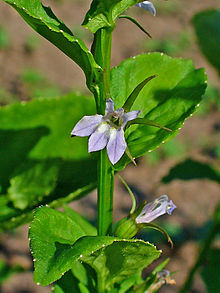(Lobelia inflata)
Lobelia inflata (Indian Tobacco) is a species of Lobelia native to eastern North America, from southeastern Canada (Nova Scotia to southeast Ontario) south through the eastern United States to Alabama and west to Kansas.
 |
| Lobelia inflata. Flower |
Lobelia inflata is also used by herbalists for treatment of asthma, hence its other nickname, asthma weed. Some make ointments of the plant to use externally.
It is also said that plant material is burned as a natural bug repellent to keep away insects such as mosquitoes.
 |
| Lobelia inflata. Flower |
Part used: plant and seeds.
Properties: antispasmodic, emetic, nervine, expectorant.
What it affect: nerves, lungs, stomach, muscles, and circulation.
Preparation and amount:
Infusion: steep 5-15 min. and take 1 tbsp. as needed.
Tincture: Take 10-30 drops as needed.
Fluid extract: drink 5-30 drops as needed.
Powder: take 1-2 #0 capsules (1-10 grains) as needed.
Purposes:
Lobelia is both a relaxant and stimulant, and is a powerful helper.
Internally, in very small doses (5-10 drops of the tincture or one gelatin capsule), it is extremely relaxing for all spasms, both internally and externally; and it is used for lung congestion and as an antispasmodic in herbal formulas. In slightly larger doses (15 drops), it acts as a sedative. In large doses (40 drops of the tincture, or 2 gelatin capsules or more), it is powerful emetic, and can be used to vomit up something which you want to get out of the stomach fast! For most conditions (unless you want to induce vomiting), you will only use small doses.
In small doses: Lobelia is very good for asthma and whooping cough. It is outstanding for relieving spasms associated with lung and respiratory conditions. As an expectorant, it is useful in all respiratory treatments, especially the spasmodic type, in expelling phlegm. Add it to all cough medicines. Combine it with lady's slipper for convulsions. Lobelia is also used for headache, heart palpitation, indigestion, allergies, arthritis, asthma, chicken pox,contagious diseases, fever (all kinds), jaundice, pleurisy, pneumonia, St. Vitus dance, teething, toothache. It relaxes the heart and lowers rapid pulse. Combined with skullcap and lady's slipper, it is good for lock jaw.
In large doses: it is invaluable for clearing the stomach of its contents, food poisoning .
Small doses: Externally, lobelia is a wash for infected or itchy skin diseases. It is put in baths, fomentations, poultices, and liniments for muscles spasms. Place in the ear a few drops of the tincture will relieve ear aches.Bruises, felons, sprains, erysipelas, ringworm snake and insect bites, poison ivy and tumors is also used in poultices.Add it to liniments for sore muscles, pains and rheumatism.
Warning:
Although it is poisonous in large amounts so do not give a very large doses of lobelia, it will be vomited so fast as to unlikely cause any permanent harm.
Properties: antispasmodic, emetic, nervine, expectorant.
What it affect: nerves, lungs, stomach, muscles, and circulation.
Preparation and amount:
Infusion: steep 5-15 min. and take 1 tbsp. as needed.
Tincture: Take 10-30 drops as needed.
Fluid extract: drink 5-30 drops as needed.
Powder: take 1-2 #0 capsules (1-10 grains) as needed.
Purposes:
Lobelia is both a relaxant and stimulant, and is a powerful helper.
Internally, in very small doses (5-10 drops of the tincture or one gelatin capsule), it is extremely relaxing for all spasms, both internally and externally; and it is used for lung congestion and as an antispasmodic in herbal formulas. In slightly larger doses (15 drops), it acts as a sedative. In large doses (40 drops of the tincture, or 2 gelatin capsules or more), it is powerful emetic, and can be used to vomit up something which you want to get out of the stomach fast! For most conditions (unless you want to induce vomiting), you will only use small doses.
In small doses: Lobelia is very good for asthma and whooping cough. It is outstanding for relieving spasms associated with lung and respiratory conditions. As an expectorant, it is useful in all respiratory treatments, especially the spasmodic type, in expelling phlegm. Add it to all cough medicines. Combine it with lady's slipper for convulsions. Lobelia is also used for headache, heart palpitation, indigestion, allergies, arthritis, asthma, chicken pox,contagious diseases, fever (all kinds), jaundice, pleurisy, pneumonia, St. Vitus dance, teething, toothache. It relaxes the heart and lowers rapid pulse. Combined with skullcap and lady's slipper, it is good for lock jaw.
In large doses: it is invaluable for clearing the stomach of its contents, food poisoning .
Small doses: Externally, lobelia is a wash for infected or itchy skin diseases. It is put in baths, fomentations, poultices, and liniments for muscles spasms. Place in the ear a few drops of the tincture will relieve ear aches.Bruises, felons, sprains, erysipelas, ringworm snake and insect bites, poison ivy and tumors is also used in poultices.Add it to liniments for sore muscles, pains and rheumatism.
Warning:
Although it is poisonous in large amounts so do not give a very large doses of lobelia, it will be vomited so fast as to unlikely cause any permanent harm.
Plant Description:
| The herb is named after the botanist Matthias de Lobel, a native of Lille, who died in London in 1616. It is an erect annual or biennial herb, 1 to 2 feet high; lower leaves and also flower are stalked, the latter being pale violet-blue in colour, tinted pale yellow within. Commercially, it is usually prepared in compressed, oblong packages, by the Shakers of New Lebanon for importation into England. The colour is a yellowish green, the odour irritating, the taste, after chewing, very like that of tobacco, burning and acrid, causing a flow of saliva. The powder has a greenish colour, but that of the seeds is brown, and stains paper with grease. |
No comments:
Post a Comment